Ranked Player Survey: to get to the next level, add THESE shots to your game
3/27/2023 | by AmateurGolf.com Staff

We asked top ams what difference-making shot they have had to learn; several stood out but we heard one answer more than any other
This is the second in a series of Ranked Player articles, using information gathered by surveys from players listed in our various rankings. So who are these players? Find out here: Ranked Player Survey: top amateur golfers share what they think...and what they know
In the first of our Ranked Player survey articles, we got an idea of just how dedicated the world's top juniors, amateurs, mid-ams, seniors and super seniors are to competitive golf.
A reflection of this dedication is the desire to keep improving one's game by finding ways to score lower and finish higher in the top events in amateur golf.
We asked our ranked amateur players what shots they have added to their games that have really paid off in competition, and we got a number of interesting and often very detailed answers throughout the bag. We detail the top categories of answers below, but one particular shot was named more than any other.
Q: What specific type of shot have you added to your game (whether more recently or long ago) that has really paid off for you in competition?
The #1 answer:
As it turns out, the #1 difference-making shot has many names: cut, fade, slider, anti-hook, fairway-finder. But all refer to the same shape; a ball flight that curves away from the player -- a left-to-right ball flight for right-handers, right-to-left for lefties -- that translates into more accuracy off the tee, and better distance control on the irons.
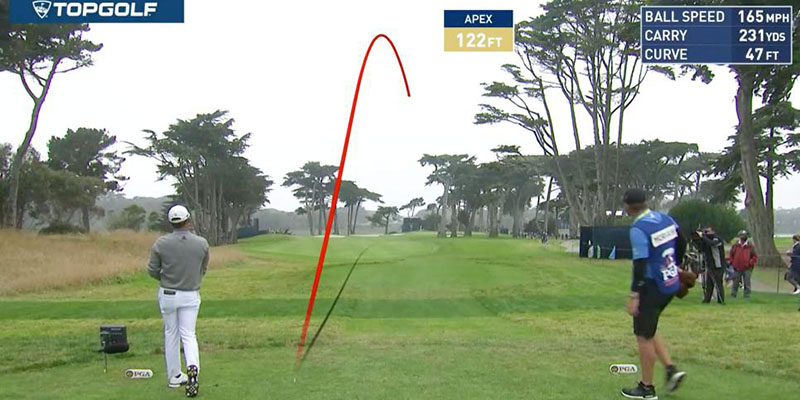
Collin Morikawa, who won 3 of our California Player-of-the-Year points races, hit a memorable cut driver on 16 at TPC Harding Park to make eagle and win his first major at the 2020 PGA Championship (broadcast screenshot)
"A fade. For years I couldn't fade the ball for the life of me, but in the last 2 years I taught myself to hit a baby fade, especially with longer irons and woods. Sometimes reaching par 5s you need a softer landing and a spinner coming in with a wood, this helped me hold more greens and keep me in better position to score." - Bailey Shoemaker, Dade City, Fla.; 2022 U.S. Women's Amateur semifinalist and U.S. Women's Open participant (finished T49).
"About a year ago, decided to change my ball flight and only hit fades and cuts, after only playing a draw my whole life. Since then, I’ve grown to be a much better ball striker and has helped me score a lot better in tournaments too." - Tiger Tahvildari, Santa Ana, Calif.
"Less hook and a slight fade." - Brad Nurski, St. Joseph, Mo.; 2019 Birmingham National Invitational champion and 2014 U.S. Mid-Amateur runner-up.
"A low cut off the tee. It’s a fairway finder. Great for when I get nervous." - Jamie Miller, Orchard Park, N.Y.
Have you ever heard a player or announcer refer to "eliminating one side of the golf course" as a key to accuracy? Right-handed players who hit cuts off the tee will often talk about eliminating the left side of the hole. Of course, this does not mean that the player will never miss a shot to the left, it is more the feeling that a reliable left-to-right ball flight allows the player to aim left without fear of missing it there, essentially "widening" the target off the tee.
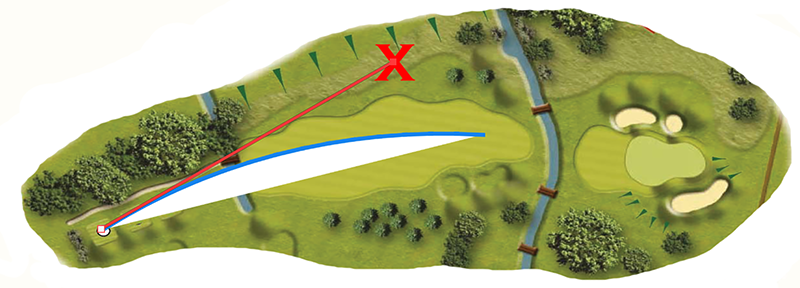
"Eliminating the left side": a left-to-right fader can feel comfortable aiming left and know that the ball will be moving toward the fairway throughout its flight
"Cut shot; it has 95% of the time eliminated the left side of the golf course. I can aim at the water hazard down the left side of a fairway and feel confident in cutting the ball to the middle of the fairway." - Bev Hargraves, Helena, Ark.; Arkansas Golf Hall-of-Famer with over 80 tournament victories.
"For me it’s the fade with the driver. I want to be able to eliminate the left miss. I feel like I can set up down the left side of a hole and know I have the entire fairway to work with. I am only average in length off the tee so it’s critical for me to know I keep the ball in play." - Bryan Rodgers, Knoxville, Tenn.
"Adding a go-to fairway finder that takes the left side of the golf course out of play has been a big help." - Taylor Thompson, Louisville, Ky.
Other popular answers:
"Dialing in" wedges by controlling the trajectory and spin
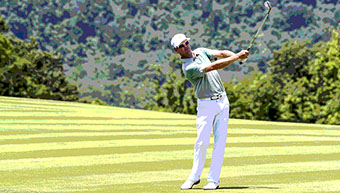 The ability to hit, for example, a 62-yarder exactly 62 yards is key to not only making birdies, but also saving par when something goes wrong off the tee.
The ability to hit, for example, a 62-yarder exactly 62 yards is key to not only making birdies, but also saving par when something goes wrong off the tee.
"Recently I have gotten much stronger in the 40-80 yard range which used to be one of the weaker areas of my game. I now lean on this distance trying to make birdie on par 5s and shorter par 4s. This also becomes a huge momentum saver if I am in trouble and can pitch out to a number I like and still save a par. - Bobby Bucey, Concord, Calif.; 2018 California Amateur champion.
"Having three different shots with all my wedges so that I am comfortable with most yardages from 125 yards and in." - Mike Williams, Indianapolis, Ind.
"I have added a variety of different wedges with varying trajectories based on the approach required." - Reagan Southerland, Atlanta, Ga.; University of North Carolina women's golf commit.
"Having 4 wedges and being dialed in to those yardages." - Bill Williamson, Cincinnati, Ohio; former U.S. Mid-Amateur runner-up, 3-time Ohio Mid-Am champ.
Three-quarter shots to reduce spin and trajectory
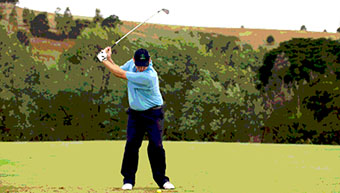 When under pressure it can be easy to get quick with the swing, and many players find that a shorter, smoother swing can help retain control, especially when the wind kicks up.
When under pressure it can be easy to get quick with the swing, and many players find that a shorter, smoother swing can help retain control, especially when the wind kicks up.
"A controlled three-quarter swing so I won't hit it in trouble." - Jackie Rogowicz, Yardley, Pa.; 2019 Women's Porter Cup champion.
"3/4 knock down shot in the wind. We play several top tourneys in windy areas." - Steve McPherson, Hemet, Calif.; top-15 senior.
"Flighting irons and wedges by taking more club and chipping it." - anonymous Big Ten college senior, top 200 world.
Shots throughout the bag:
Overall, there were about as many answers to this question as there are shots in golf. Jason Anthony has employed the driver off the deck of a tee box. Brandon Parker added the stinger 2-iron. For Robbie Dew, it's being able to hold a shot against a crosswind. For Louise Burke of England it's a punch shot. For one of the top-ranked players in Arizona, it's the high-spinning bunker shot. Dennis Martin has added the high flop shot. For 2019 British Boys champ Tom Gueant of France, it was mastering the standard chip shot. Randy Haag initiated face-on putting. And Dalton Melnyk became automatic from 5 feet and in.
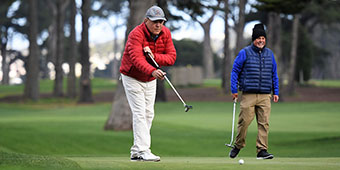
This is the shot Randy Haag added to his game
(Mike Benham/AmateurGolf.com photo)
There were many other answers, from a low-teed "bunt" driver off the tee, to the 50-100 yard bunker shot, to using a hybrid from off the green.
But while the answers may have varied, one thing was constant across our survey respondents: their ability to identify a weakness in their game, whatever it is, and work to master it.
Strategies Collide: Working the Ball vs. Having a Stock Shot
One of the more interesting recent developments in golf is the emergence of data-driven systems like DECADE and others that analyze millions of golf shots and help golfers determine their ideal strategy on each shot.
One of the tenets of these systems is that a player will benefit more from having a stock shot -- that is, one shot shape that the player masters and relies on exclusively -- than he/she will from trying to shape the ball both ways (left-to-right, right-to-left) depending on the situation. Many young tour pros and college players use the stock-shot approach. But many of the greats of the game like Tiger Woods, Jack Nicklaus and others have been outspoken about the importance of working the ball both ways depending on where the pin is or which way the hole bends.
We saw an interesting divide among some of our ranked players when responding to the main question of this article.
"Having a stock shot that I try to hit 99 percent of the time." - Connor Jones, Westminster, Colo.; Colorado Amateur champion and Mountain West Conference individual champion representing Colorado State.
"Make sure to have one reliable ball flight." - Tyler Stahle, Andover, Mass.
"Removing shots from my arsenal has actually helped me more." - Harley Abrams, Tulsa, Okla.
"Being able to work the ball lower, higher, right or left." - Kary Hollenbaugh, New Albany, Ohio; Ohio State Women's golfer who once shot 60 in high school.
"Being confident in working the ball both ways." - Bob Royak, Alpharetta, Ga.; 2019 U.S. Senior champion, reigning Coleman and Jones Cup senior champ.
So who is right, the stock-shot players or the ball-workers? They both are! That's the beauty of the game -- there is no one right way to play and the challenge is to find what works best for you.
Be sure to revisit AmateurGolf.com as we continue our Ranked Player Survey series, sharing the expertise and experience of our group of ranked player survey respondents.
In the first of our Ranked Player survey articles, we got an idea of just how dedicated the world's top juniors, amateurs, mid-ams, seniors and super seniors are to competitive golf.
A reflection of this dedication is the desire to keep improving one's game by finding ways to score lower and finish higher in the top events in amateur golf.
Q: What specific type of shot have you added to your game (whether more recently or long ago) that has really paid off for you in competition?
The #1 answer:
As it turns out, the #1 difference-making shot has many names: cut, fade, slider, anti-hook, fairway-finder. But all refer to the same shape; a ball flight that curves away from the player -- a left-to-right ball flight for right-handers, right-to-left for lefties -- that translates into more accuracy off the tee, and better distance control on the irons.

Collin Morikawa, who won 3 of our California Player-of-the-Year points races, hit a memorable cut driver on 16 at TPC Harding Park to make eagle and win his first major at the 2020 PGA Championship (broadcast screenshot)
"A fade. For years I couldn't fade the ball for the life of me, but in the last 2 years I taught myself to hit a baby fade, especially with longer irons and woods. Sometimes reaching par 5s you need a softer landing and a spinner coming in with a wood, this helped me hold more greens and keep me in better position to score." - Bailey Shoemaker, Dade City, Fla.; 2022 U.S. Women's Amateur semifinalist and U.S. Women's Open participant (finished T49).
"About a year ago, decided to change my ball flight and only hit fades and cuts, after only playing a draw my whole life. Since then, I’ve grown to be a much better ball striker and has helped me score a lot better in tournaments too." - Tiger Tahvildari, Santa Ana, Calif.
"Less hook and a slight fade." - Brad Nurski, St. Joseph, Mo.; 2019 Birmingham National Invitational champion and 2014 U.S. Mid-Amateur runner-up.
"A low cut off the tee. It’s a fairway finder. Great for when I get nervous." - Jamie Miller, Orchard Park, N.Y.
Have you ever heard a player or announcer refer to "eliminating one side of the golf course" as a key to accuracy? Right-handed players who hit cuts off the tee will often talk about eliminating the left side of the hole. Of course, this does not mean that the player will never miss a shot to the left, it is more the feeling that a reliable left-to-right ball flight allows the player to aim left without fear of missing it there, essentially "widening" the target off the tee.

"Eliminating the left side": a left-to-right fader can feel comfortable aiming left and know that the ball will be moving toward the fairway throughout its flight
"Cut shot; it has 95% of the time eliminated the left side of the golf course. I can aim at the water hazard down the left side of a fairway and feel confident in cutting the ball to the middle of the fairway." - Bev Hargraves, Helena, Ark.; Arkansas Golf Hall-of-Famer with over 80 tournament victories.
"For me it’s the fade with the driver. I want to be able to eliminate the left miss. I feel like I can set up down the left side of a hole and know I have the entire fairway to work with. I am only average in length off the tee so it’s critical for me to know I keep the ball in play." - Bryan Rodgers, Knoxville, Tenn.
"Adding a go-to fairway finder that takes the left side of the golf course out of play has been a big help." - Taylor Thompson, Louisville, Ky.
Other popular answers:
"Dialing in" wedges by controlling the trajectory and spin

"Recently I have gotten much stronger in the 40-80 yard range which used to be one of the weaker areas of my game. I now lean on this distance trying to make birdie on par 5s and shorter par 4s. This also becomes a huge momentum saver if I am in trouble and can pitch out to a number I like and still save a par. - Bobby Bucey, Concord, Calif.; 2018 California Amateur champion.
"Having three different shots with all my wedges so that I am comfortable with most yardages from 125 yards and in." - Mike Williams, Indianapolis, Ind.
"Having 4 wedges and being dialed in to those yardages." - Bill Williamson, Cincinnati, Ohio; former U.S. Mid-Amateur runner-up, 3-time Ohio Mid-Am champ.
Three-quarter shots to reduce spin and trajectory

"A controlled three-quarter swing so I won't hit it in trouble." - Jackie Rogowicz, Yardley, Pa.; 2019 Women's Porter Cup champion.
"3/4 knock down shot in the wind. We play several top tourneys in windy areas." - Steve McPherson, Hemet, Calif.; top-15 senior.
"Flighting irons and wedges by taking more club and chipping it." - anonymous Big Ten college senior, top 200 world.
Shots throughout the bag:
Overall, there were about as many answers to this question as there are shots in golf. Jason Anthony has employed the driver off the deck of a tee box. Brandon Parker added the stinger 2-iron. For Robbie Dew, it's being able to hold a shot against a crosswind. For Louise Burke of England it's a punch shot. For one of the top-ranked players in Arizona, it's the high-spinning bunker shot. Dennis Martin has added the high flop shot. For 2019 British Boys champ Tom Gueant of France, it was mastering the standard chip shot. Randy Haag initiated face-on putting. And Dalton Melnyk became automatic from 5 feet and in.

This is the shot Randy Haag added to his game
(Mike Benham/AmateurGolf.com photo)
But while the answers may have varied, one thing was constant across our survey respondents: their ability to identify a weakness in their game, whatever it is, and work to master it.
Strategies Collide: Working the Ball vs. Having a Stock Shot
One of the more interesting recent developments in golf is the emergence of data-driven systems like DECADE and others that analyze millions of golf shots and help golfers determine their ideal strategy on each shot.
One of the tenets of these systems is that a player will benefit more from having a stock shot -- that is, one shot shape that the player masters and relies on exclusively -- than he/she will from trying to shape the ball both ways (left-to-right, right-to-left) depending on the situation. Many young tour pros and college players use the stock-shot approach. But many of the greats of the game like Tiger Woods, Jack Nicklaus and others have been outspoken about the importance of working the ball both ways depending on where the pin is or which way the hole bends.
We saw an interesting divide among some of our ranked players when responding to the main question of this article.
"Having a stock shot that I try to hit 99 percent of the time." - Connor Jones, Westminster, Colo.; Colorado Amateur champion and Mountain West Conference individual champion representing Colorado State.
"Make sure to have one reliable ball flight." - Tyler Stahle, Andover, Mass.
"Being able to work the ball lower, higher, right or left." - Kary Hollenbaugh, New Albany, Ohio; Ohio State Women's golfer who once shot 60 in high school.
"Being confident in working the ball both ways." - Bob Royak, Alpharetta, Ga.; 2019 U.S. Senior champion, reigning Coleman and Jones Cup senior champ.
So who is right, the stock-shot players or the ball-workers? They both are! That's the beauty of the game -- there is no one right way to play and the challenge is to find what works best for you.
Be sure to revisit AmateurGolf.com as we continue our Ranked Player Survey series, sharing the expertise and experience of our group of ranked player survey respondents.
Most Popular Articles
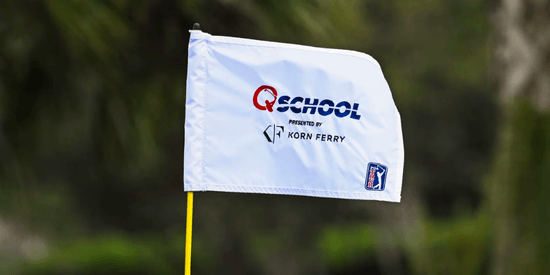
2025 PGA TOUR Q-School Guide: Sites, Scores, and Who Advanced
Dec 5, 2025Second Stage is complete and Final Stage awaits at Sawgrass — follow every Q-School leaderboard and the players still chasing
2025 LPGA TOUR Q-Series: Final Qualifying Stage FINAL SCORING
Dec 8, 2025Helen Briem earns medalist honors, 31 players headed to the LPGA next year
Australian Open at Royal Melbourne: Preview, amateur bios, and how to watch
Nov 30, 2025Rory McIlroy headlines one of the championship's top fields in years - at least four amateurs will have their chance at glory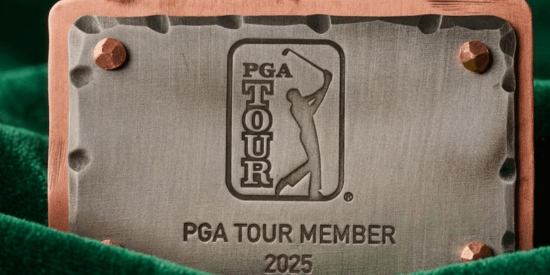
2025 PGA TOUR Q-School Final Stage: Ewart Leads Five New TOUR Card Winners
Dec 14, 2025A.J. Ewart topped Final Stage at TPC Sawgrass, leading five players who secured PGA TOUR membership for 2026.
Luke Ringkamp Cruises to Rolex Tournament of Champions Title at TPC San Antonio
Nov 26, 2025One week after committing to Pepperdine, Luke Ringkamp won the Rolex Tournament of Champions by nine shots.Loading latest news...
